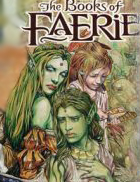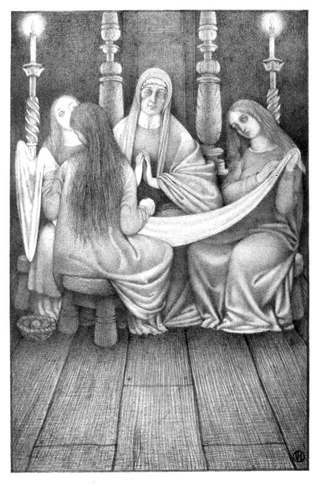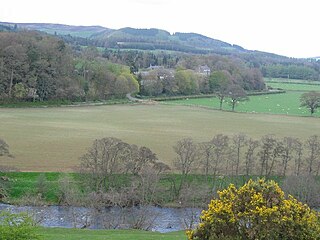
Sir Thomas de Ercildoun, better remembered as Thomas the Rhymer, also known as Thomas Learmont or True Thomas, was a Scottish laird and reputed prophet from Earlston in the Borders. Thomas' gift of prophecy is linked to his poetic ability.

The Yarrow Water is a river in the Borders in the south east of Scotland. It is a tributary of the Ettrick Water and renowned for its high quality trout and salmon fishing. The name "Yarrow" may derive from the Celtic word garw meaning "rough" or possibly share a derivation with the English name "Jarrow".

Titania is a fictional character, a comic book faerie published by DC Comics. She first appeared in The Sandman #19, and was created by Neil Gaiman and Charles Vess. She is inspired by and implied to be the same as Titania as the faerie queen in William Shakespeare's play A Midsummer Night's Dream.
Fairyland (Early Modern English: Faerie; Scots: Elfame in English and Scottish folklore is the fabulous land or abode of fairies or fays. Old French faierie referred to an illusion or enchantment, the land of the faes. Modern English fairy transferred the name of the realm of the fays to its inhabitants, e.g., the expression fairie knight in Edmund Spenser's The Faerie Queene refers to a "supernatural knight" or a "knight of Faerie" but was later re-interpreted as referring to a knight who is "a fairy".

Fire and Hemlock is a modern fantasy by British author Diana Wynne Jones, based largely on the Anglo-Scottish Border ballads "Tam Lin" and "Thomas the Rhymer".

"Matty Groves", also known as "Little Musgrave and Lady Barnard" or "Little Musgrave", is a ballad probably originating in Northern England that describes an adulterous tryst between a young man and a noblewoman that is ended when the woman's husband discovers and kills them. It is listed as Child ballad number 81 and number 52 in the Roud Folk Song Index. This song exists in many textual variants and has several variant names. The song dates to at least 1613, and under the title Little Musgrave and Lady Barnard is one of the Child ballads collected by 19th-century American scholar Francis James Child.
"Allison Gross" is a traditional ballad, catalogued as Child Ballad #35. It tells the story of "the ugliest witch in the north country" who tries to persuade a man to become her lover and then punishes him by a transformation.

The Perilous Gard is an American young adult novel by Elizabeth Marie Pope, published in 1974. It was awarded the Newbery Honor in 1975.
"Lady Isabel and the Elf Knight" is the English common name representative of a very large class of European ballads.

"The Twa Sisters" is a traditional murder ballad, dating at least as far back as the mid 17th century. The song recounts the tale of a girl drowned by her jealous sister. At least 21 English variants exist under several names, including "Minnorie" or "Binnorie", "The Cruel Sister", "The Wind and Rain", "Dreadful Wind and Rain", "Two Sisters", "The Bonny Swans" and the "Bonnie Bows of London". The ballad was collected by renowned folklorist Francis J. Child as Child Ballad 10 and is also listed in the Roud Folk Song Index. Whilst the song is thought to originate somewhere around England or Scotland, extremely similar songs have been found throughout Europe, particularly in Scandinavia.
The Famous Flower of Serving-Men or The Lady turned Serving-Man is a traditional English language folk song and murder ballad. Child considered it as closely related to the ballad "The Lament of the Border Widow" or "The Border Widow's Lament".
"Unusually, it is possible to give a precise date and authorship to this ballad. It was written by the prolific balladeer, Laurence Price, and published in July 1656, under the title of The famous Flower of Serving-Men. Or, The Lady turn'd Serving-Man. It lasted in the mouths of ordinary people for three hundred years: what a tribute to the work of any writer, leave alone the obscure Laurence Price. Oral tradition, however, has made changes. The original has twenty-eight verses and a fairy-tale ending: “And then for fear of further strife, / he took Sweet William to be his Wife: / The like before was never seen, / A Serving-man to be a Queen”. – Roy Palmer, A Book of British Ballads
"Young Beichan", also known as "Lord Bateman", "Lord Bakeman", "Lord Baker", "Young Bicham" and "Young Bekie", is a traditional folk ballad categorised as Child ballad 53 and Roud 40. The earliest versions date from the late 18th century, but it is probably older, with clear parallels in ballads and folktales across Europe. The song was popular as a broadside ballad in the nineteenth century, and survived well into the twentieth century in the oral tradition in rural areas of most English speaking parts of the world, particularly in England, Scotland and Appalachia.

"Lord Thomas and Fair Annet", also known as "Lord Thomas and Fair Eleanor", is an English folk ballad.
"The Knight and the Shepherd’s Daughter" is an English ballad, collected by Francis James Child as Child Ballad 110 and listed as number 67 in the Roud Folk Song Index.

"The Twa Brothers" is a traditional ballad existing in many variants.

Tam Lin is a 1991 contemporary fantasy novel by United States author Pamela Dean, who based it on the traditional Scottish border ballad "Tam Lin".

Carterhaugh is a wood and farm near the confluence of the Yarrow Water and the Ettrick Water near Selkirk in the Scottish Borders. This real location shares its name with the fictional setting for the meeting between Tam Lin and Janet in the ballad "Tam Lin". This is commemorated in the name of Tamlane's Well, on the roadside outside Carterhaugh Farm. The link between the location and the ballad is debated.

Faerie, The Fair Lands or The Twilight Realm is one of two fictional otherdimensional homelands for the Faerie, as published by DC Comics. The Vertigo Comics realm of Faerie is an amalgam of the mythological realms of Álfheimr, Otherworld, the Fortunate Isles, Tír na nÓg and Avalon. This mix is heavily influenced by Shakespeare's play A Midsummer Night's Dream. It is home to the faeries and other mythical races, ruled over by the Seelie Court and King Auberon and Queen Titania. Faerie debuted in The Books of Magic #3, and was created by Neil Gaiman and Charles Vess.
Queen of Elphame or "Elf-hame", in the folklore belief of Lowland Scotland and Northern England, designates the elfin queen of Faerie, mentioned in Scottish witch trials. In ballads and contemporary texts, she is referred to as Queen of Elphane, Elphen, or the Fairies. She is equivalent to the Queen of Fairy who rules Faërie or Fairyland. The character as described in witch trials has many parallels with the legends of Thomas the Rhymer and Tam Lin.

In folklore and literature, the Fairy Queen or Queen of the Fairies is a female ruler of the fairies, sometimes but not always paired with a king. Depending on the work, she may be named or unnamed; Titania and Mab are two frequently used names. Numerous characters, goddesses or folkloric spirits worldwide have been labeled as Fairy Queens.
















